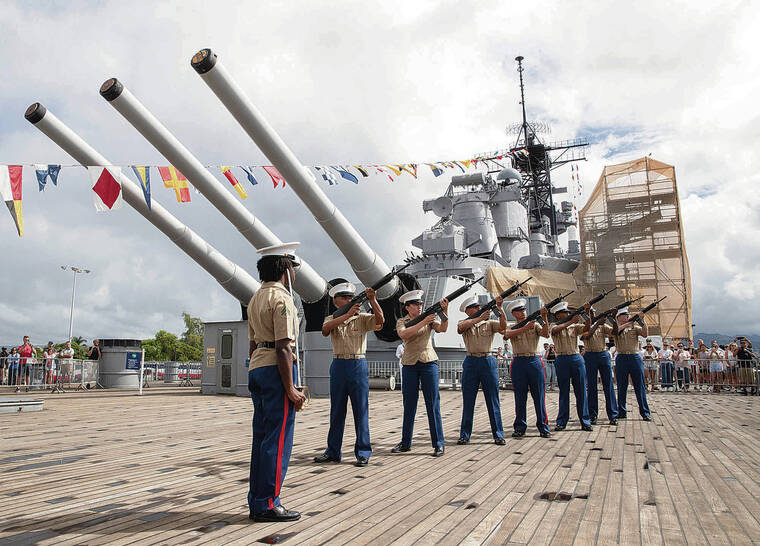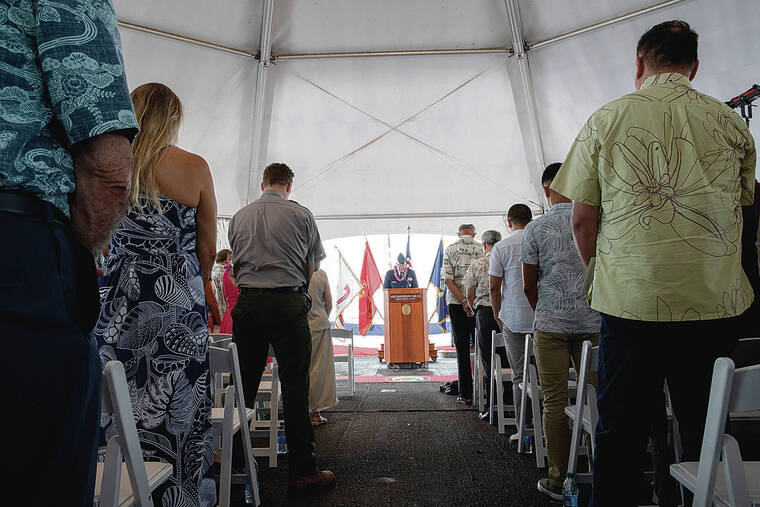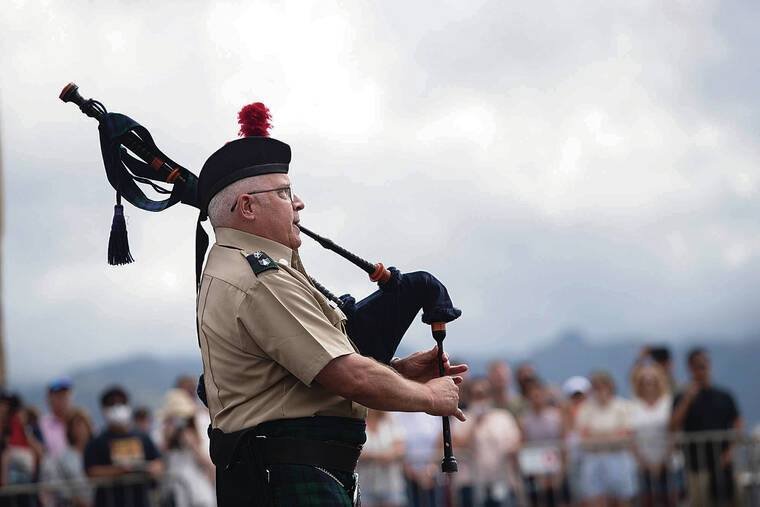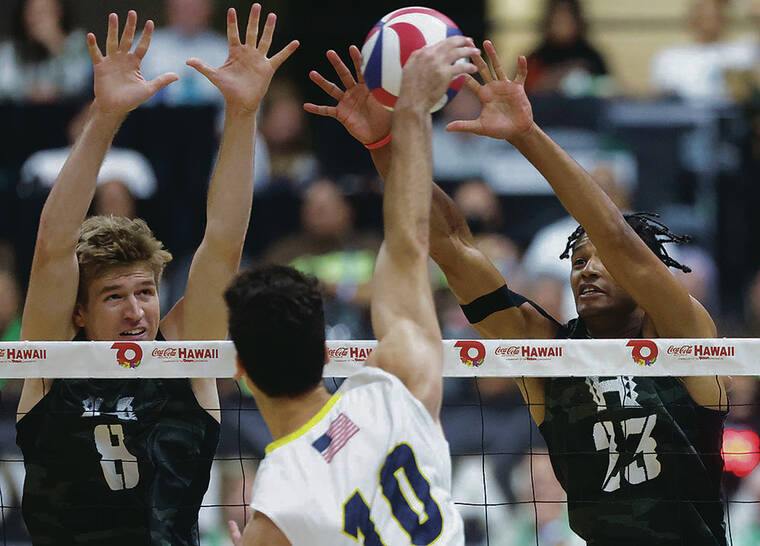Pearl Harbor ceremony commemorates end of World War II, Battle of Midway

CINDY ELLEN RUSSELL / CRUSSELL@STARADVERTISER.COM
A ceremony commemorating the 77th anniversary of the end of World War II and the 80th anniversary of the Battle of Midway was held Friday aboard the Battleship Missouri Memorial at Pearl Harbor. Above, U.S. Marines stood in formation for a rifle salute.

CINDY ELLEN RUSSELL / CRUSSELL@STARADVERTISER.COM
Headquarters Pacific Air Forces Command Chaplain Col. James A. Hamel, center, ended Friday’s ceremony with a benediction.

CINDY ELLEN RUSSELL / CRUSSELL@STARADVERTISER.COM
Rick Jackson, from the Celtic Pipes and Drums of Hawai‘i performed “Amazing Grace.”



A ceremony Friday on the deck of the Battleship Missouri Memorial in Pearl Harbor marked both the 77th anniversary of the end of World War II and the 80th anniversary of the Battle of Midway, an American victory over Japan that proved to be the turning point of the war in the Pacific.
The final surrender of the Japanese Empire was signed aboard the former battleship, but the event was as much about the present as it was the past, as geopolitical tensions again grip the Pacific. The event’s keynote speaker, John Tokar, chief of the National Security Agency’s Center for Cryptologic History, told the audience, “This is not history for history’s sake.”
He gave a detailed account of the role that code-breaking and intelligence-gathering played in turning the tide of the war in the Pacific at Midway Atoll, located about 1,120 miles northwest of Hawaii.
“Since the devastating attack on Pearl Harbor on Dec. 7, 1941, Japan had been unstoppable in achieving its wartime aims,” he said.
The Japanese Imperial Navy had the upper hand over the U.S. Pacific Fleet. Though it had failed to eliminate American aircraft carriers during the attack on Pearl Harbor, it still inflicted critical damage and robbed the U.S. Navy of key resources.
By the time the Battle of Midway began on June 4, 1942, the Japanese Navy had six aircraft carriers and 11 battleships at its disposal, while the Pacific Fleet had just three aircraft carriers and no battleships available.
Don't miss out on what's happening!
Stay in touch with breaking news, as it happens, conveniently in your email inbox. It's FREE!
“The U.S. could not yet match the brawn of Japan’s combined fleet, and they’d have to find a more cerebral solution to counter the Japanese military machine,” said Tokar.
American intelligence officers made use of code breakers and Japanese linguists to predict the moves of the Japanese fleet and also trick Japanese commanders by sending false signals.
When the two forces faced off at Midway, the Japanese sank an American aircraft carrier, destroyed 150 warplanes and sank a U.S. Navy destroyer. But American forces inflicted greater losses, sinking four enemy aircraft carriers and destroying 248 Japanese aircraft.
By the time the battle came to an end on June 7, 1942, it had claimed the lives of 307 American and 3,057 Japanese service members.
“Rapidly maturing U.S. cryptologic expertise predicted the time, location and size of Japan’s next big offensive action,” said Tokar. “The U.S. was able to ambush the Imperial Navy at and around Midway, inflicting destruction from which they would never fully recover.”
In remarks to the crowd, Navy Capt. Christopher Eng, the NSA’s top officer in Hawaii, talked about how signal intelligence and modern technology remains relevant in the Pacific 80 years after the pivotal Midway battle.
“We are currently faced with a vastly different than the one we faced in 1942 at Midway,” he told the audience.
He noted North Korea’s use of cyber weapons to steal money online to fund its ambitious weapons development programs. He also accused China of widespread theft of technology and intellectual property to bolster its economy and military, and of “using the technologies that are meant to connect the world in order to exert a more authoritarian control over populations.”
The NSA also has been subject to harsh criticism for its own wide-ranging surveillance activities. In 2013, Hawaii-based NSA contractor Edward Snowden leaked thousands of classified files detailing sprawling domestic and global U.S. surveillance operations.
But many analysts believe China’s rapidly emerging surveillance state could dwarf any other such effort in history.
“(The People’s Republic of China) is the only competitor potentially capable of combining its power — economic, diplomatic, military and technological — to threaten a stable and open international system,” said Eng.
Relations between the U.S. and China are currently at a low point. In August Chinese officials broke off all military and climate talks with the United States in response to House Speaker Nancy Pelosi’s visit to self-governing Taiwan, which China views as a separatist region that Chinese President Xi Jinping has vowed to bring under Beijing’s control.
During the ceremony, speakers highlighted the importance of the relationship between the former enemies, the U.S. and Japan, as tensions again simmer in the Pacific.
“Seventy-seven years ago World War II ended and a partnership began between Japan and the United States that endures to this day,” said retired Navy Rear Adm. Alma Grocki. “It wasn’t always smooth, and it wasn’t always congenial. But citizens of each country knew how important this partnership was. And eventually, over time, this partnership strengthened into an alliance.”
But wounds of that destructive war are still felt deeply 77 years after its conclusion.
Among those in attendance at the ceremony was 98-year-old Lucio Sanico, a U.S. Army veteran who served during both World War II and the Korean War. He said he thought it was a good ceremony but was reluctant to share his own reflections on his wartime experiences.
“I like to keep those things inside me,” he said. “I cannot bring back my buddies who passed away.”





